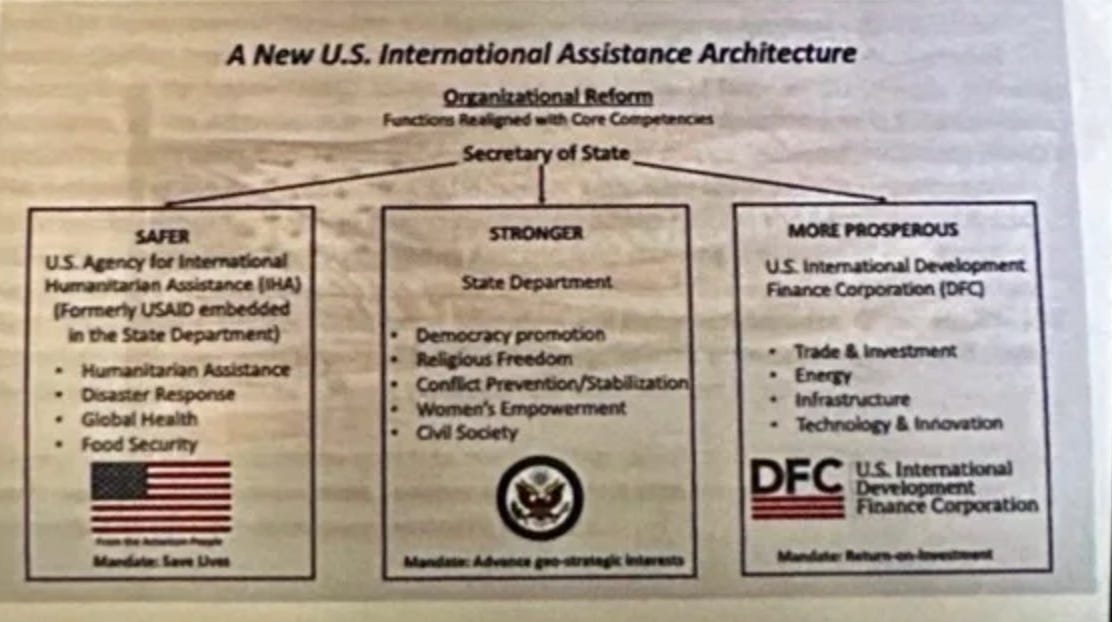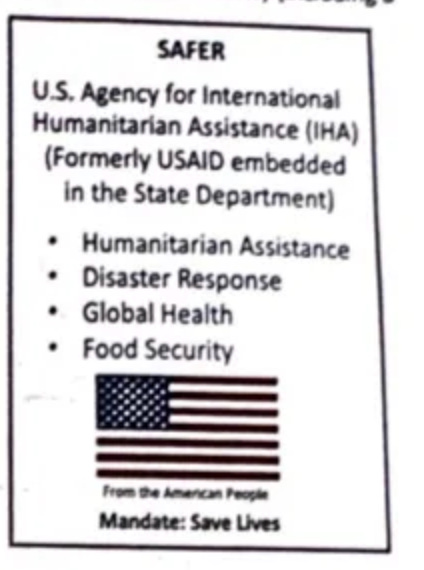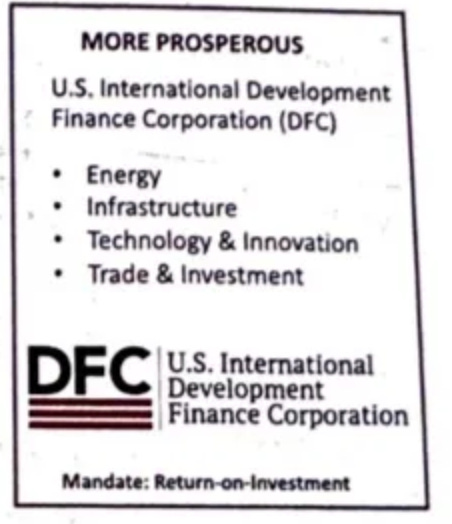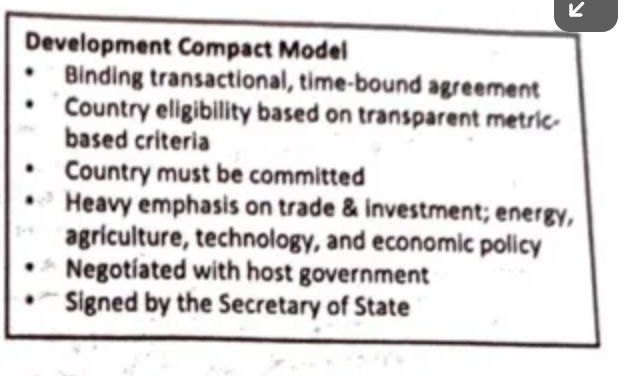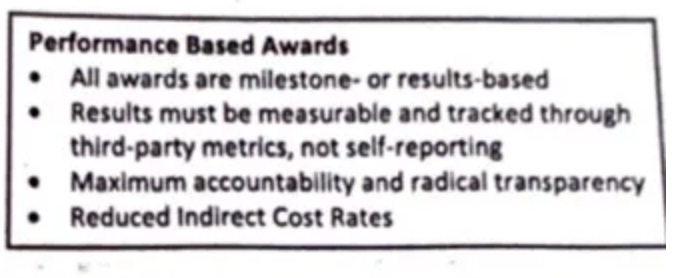TEXT VERSION: The Memo That Will Destroy U.S. International Assistance...
...and replace it with a corrupt patronage system serving the interests of Trump family and friends. Who else is going to get all that taxpayer subsidized private-sector investment support?
DESIGNING A NEW U.S. INTERNATIONAL ASSISTANCE ARCHITECTURE
INTRODUCTION
The U.S. international assistance apparatus is inefficient and fragmented. A tangled web of overlapping mandates, chronic mission creep, and Congressional micromanagement has produced a system without strategic alignment that attempts to be “all things to all people.” This complexity generates an incoherent portfolio of programs, many disconnected from American interests and implemented by organizations that represent a wide array of motivations and interests. The resulting expenditures simultaneously promote dependency among those who benefit from the assistance while often not being visible enough to create goodwill for the United States.
The cyclical nature of U.S. international assistance dilutes its impact and restricts our Nation's ability to respond effectively to new global challenges. Our lack of discipline and strategic focus, as well as the absence of a unified, coordinated delivery system, has allowed our geostrategic competitors to establish dominant positions in critical sectors and regions because they have set clear objectives and deployed a more efficient and precise approach. Simply put, Congress and the executive branch have been funding and implementing programs on autopilot, rather than because the Investments served the mutual interests of the American taxpayer and our partners and we're delivering measurable results.
As Secretary Rubio has clearly stated, all U.S. International assistance initiatives should make America safer, stronger and more prosperous. turning this Vision into reality entails investing in initiatives that return clear, first order benefits back home. Such a strategic program should aim to foster peace and stability in regions critical to U.S. interests, catalyze economic opportunities that support American businesses and consumers, and mitigate Global threats such as pandemic diseases.
International assistance is an instrument of foreign policy. how that instrument is deployed determines its effectiveness. The United States had an archaic system that needed to be dismantled to fix it properly. President Trump's decisive actions have introduced an unprecedented opportunity to restructure the system and establish an international cooperation architecture that respects the taxpayer semicolon is laser focused on delivering measurable results, especially through the private sector; and aligns with America's strategic interests.
This blueprint proposes a reimagined U.S. International assistance architecture and a set of operating principles that promises measurable returns to America while also projecting American soft power; enhancing our national security semicolon and countering Global competitors, including China. Of note, this proposal offers a structural and operational architecture to position our international assistance for success but does not outline whether or the extent to which this or any Administration should financially support any one sector or program. It merely highlights what initiatives advance our national security and strategic interests, where those initiatives should be housed, and how they can be administered in a way that maximizes the return on investment for every taxpayer dollar.
Delivering Value to the American Taxpayer
The fundamental goals of U.S. international assistance should be to deliver tangible value - quantifiable returns - to the American taxpayer and advance self-reliance among our allies and partners around the world, ultimately to end the need for assistance all together. A coherent portfolio of Investments should advance economic opportunities for American companies, enhance our national security, and strengthen U.S. influence on the global stage.
A streamlined, fit-to-purpose international assistance structure that is responsive to adaptive challenges would assure Secretary Rubio and the President can deliver on this promise. By concentrating resources in areas where the United States has strategic interests, assistance initiatives can lead to more robust economic partnerships ultimately benefiting the American economy and global security landscape… and provide geopolitical leverage for the President on the global chessboard.
Incremental reforms have not worked in the past. Boldly reimagining how America delivers international assistance is the task at hand. This proposed architecture focuses on organizational and operational reforms built on three foundational questions: 1) What should we invest in? 2) Who should leave these efforts? And 3) how should we best implement them? By addressing these fundamental questions, the Trump Administration can create a system that works effectively for America's interests
1. WHAT SHOULD WE INVEST IN AND WHY SHOULD WE DO IT?
The modern reality is that we should not - and cannot - effectively engage in every sector in every country. Our international assistance apparatus has evolved into doing just that, which draws resources away from our priorities and countries critical to our national security, strategic, and economic interests. The United States must make difficult choices, and both Congress and the administration will play a crucial role in the discipline decision making process ahead.
Any cursory reading of current events would suggest that leaders of some countries are simply not committed enough to the progress of their own people to merit or justify any significant commitment of U.S. taxpayer resources. Independent metrics - hard data - support this conclusion. Nevertheless, Congress has forced multiple administrations to engage in assistance activities that disincentivize important host country Investments and reforms. Certain low-return programs have consumed a disproportionate amount of resources, and the provision of the Foreign Assistance Act of 1961 that requires 25% co-financing by host country governments has gone ignored for decades.
The Trump Administration has recognized correctly that programs that carry high cost and limited first order returns to the U.S. taxpayer should be eliminated. U.S. investments in global leadership should not be philanthropic in nature but must Advance our direct National security, strategic and Commercial interests. If structured and administered properly they are fiscally prudent and address problems before they escalate into crisis that require costly or military interventions, making them essential components of a comprehensive “peace through strength” approach to dealing with a complex and perilous world. examples include effective approaches to global health security (such as the prevention and monitoring of infectious diseases) driven by American technology advancements, as well as humanitarian and international food security programs backed by the innovation of the American private sector and our farmers across the country. These efforts can foster stability in volatile regions and prevent conditions that breed extremism and terrorism. By partnering with committed allies to help themselves, America reduces migration pressures, while establishing good and soft power that complements our principles.
Additionally, supporting American companies to trade and invest in high growth markets presents a tremendous opportunity for the Trump Administration to deliver direct capital returns to the taxpayer while bolstering jobs in the U.S. economy. This approach also serves as a strategic counter to China's Belt and Road Initiative, which has expanded the influence of the Chinese Communist party across global trade networks. By co-financing ventures in sectors such as energy, critical minerals, and infrastructure, the United States can secure resources and bolster its technological and Industrial base. Such investment not only enhances our competitive economic advantage globally but also advances America's geostrategic influence and Presidential leverage. A crucial component of this strategy is ensuring leadership in setting international standards and practices, particularly in vital areas such as artificial intelligence and the digital ecosystem.
Lastly, right-sizing precision investments in advancing geopolitical interests, led by the State Department, such as promoting democracy, preserving International religious freedom, and preventing conflict makes us stronger overseas. By advancing democracy and good governance and fighting corruption, the Trump Administration can help mitigate the risks of extremist ideologies and religious intolerance that threaten American citizens at home and abroad. Efforts to prevent conflicts and stabilize chaotic political transitions contribute to creating more stable regions, which bolsters our early warning systems and reduces the number of global hotspots that could affect us security. These initiatives prevent power vacuums that malign actors can't exploit, ultimately conserving resources and enhancing global partnerships. By focusing on these goals, the administration can reinforce a world order that aligns with American values and interests, safeguarding our long-term national security.
2. WHO SHOULD LEAD THESE EFFORTS? A NEW ASSISTANCE PLATFORM
Proper alignment of international assistance programs with appropriate agencies is integral to eliminating inefficiencies and overlapping mandates. Each agency should focus strictly on areas within its core competencies ensuring specialized expertise and optimizing resources. assigning agencies clear functional roles and strengthening cross government cooperation, can bring effective coordination to our international assistance while eliminating duplication.
This blueprint proposes a restructured framework based on three primary organizational pillars – Safer, More Prosperous, and Stronger - each clearly defined, measurable, and justified, led by three primary agencies under the policy direction of the Secretary of State.
PILLAR 1: SAFER - The U.S. Agency for International Humanitarian Assistance (IHA)
The first pillar redesigns, reconstitutes, and renames the U.S. Agency for International Development (USAID) as the U.S. Agency for International Humanitarian Assistance (IHA), a specialized entity embedded in the Department of State exclusively focused on saving lives and projecting American soft power. IHA’s mandate would be limited to the Strategic delivery of humanitarian assistance, responding to disasters, enhancing Global Health security (including a modified President's Emergency Plan for AIDS Relief) [PEPFAR]), and promoting international food security.
This narrow mandate would empower IHA to engage in areas where the President and the Secretary of State determine engagement is in America's national security or strategic interest. By responding rapidly to natural disasters, preventing famines, containing disease outbreaks, and securing peace, Iha would demonstrate American values, prevent instability that threatens our interests, distinguish ourselves from our geopolitical adversaries such as China, enhance U.S. leadership on the global stage, and increase safety at home.
The new structure would eliminate current redundancies and overlap with other agencies by bringing all lifesaving efforts under a single roof and under the leadership of the Secretary of State. in particular Iha should combine the bureaus for Global Security and diplomacy; conflict and stability operations CSO; and population refugees and migrations PRN from the Department of State with the bureaus for humanitarian assistance BHA Global Health conflict prevention and stability stabilization CPS and resilience environment and food security from the former USAID. Naming an Under-Secretary of State or the Director of Foreign Assistance as the administrator of IHA would ensure close coordination with U.S. foreign policy and, in the short-term, avoid the need for major statutory change. However, renaming USAID as IHA and making the new organization a permanent subsidiary agency of the Department of State would require Congress to amend the Foreign Affairs Reform and Restructuring Act of 1998, the Foreign Assistance act, the Pay Act, and long-standing provisions of the Appropriations Acts. Funding for IHA would come from the following current appropriation lines: International Disaster Assistance, Migration and Refugee Assistance, Global Health, and Transition Initiatives, supplemented by allocations for specific activities in food security from the Development Assistance account and Economic Support Fund.
Success would be measured by concrete metrics: lives saved, outbreaks of infectious disease contained, pandemics prevented, famines averted, and measurable increases in positive perception of the United States in emerging markets.
PILLAR 2: MORE PROSPEROUS - Merge Economic Cooperation Agencies into DFC
The second pillar would bring the Millennium challenge Corporation MCC and the U.S. Trade and Development Agency (USTDA) under the tent of the U.S. International Development Finance Corporation (DFC), with the sole focus of generating American jobs and returns to the U.S. via trade, investment, infrastructure (physical and digital), and projecting America's energy and technology dominance. The MCC and USTDA components, which should retain their authorities and criteria for investment as divisions under the DFC, would complement and/or act as precursors to pave the way for DFC supported private sector deals, depending on the country. The new entity would create a powerful counterweight to China's Belt and Road Initiative, capable of delivering high-quality infrastructure and strategic development projects in advance both American geostrategic interests and Commercial pursuits.
With a mandate focused on trade investment infrastructure, energy technology, and reforms to create better enabling environments, this merged entity would pursue capital returns, the creation of U.S. jobs, and the expansion of markets for U.S. firms. a major emphasis should be the launch of a development insurance facility. This new entity would operate with a commercial mindset, closely coordinating with the Department of Commerce, State, and Treasury, along with the export import bank, to prioritize projects that deliverable measurable returns on investment while creating opportunities for American businesses and consumers. This approach would directly support U.S. energy dominance, counter Chinese influence, secure critical minerals, and advanced technological leadership. Success would be measured by capital mobilized, financial returns generated, jobs created, and development outcomes as measured by credible independent metrics (including the MCC’s Country Scorecards and former USAID’s Self-Reliance Country Roadmaps).
It is important to note that, after the merger, the MCC division should retain its eligibility and accountability criteria and authorities for full compact in qualifying countries. In other markets, the MCC division should pursue binding, transactional, time bound agreements with national governments that complement commercial deals (see the Development Compact section below for more details). The Secretary of State would serve as the Chair of the Board of the new DFC. Funding for the new DFC would come from the MCC's appropriations, the DFC corporate capital account, and most of the development assistance account and the economic support fund. This proposed merger would require statutory changes, possible to achieve during the upcoming reauthorization process, including a significant increase in the DFC's current maximum contingent liability, clarification of its authorities to take equity positions, and permission to invest in higher income countries. The Office of Management and budget would also need to adjust the way it scores DFC's Equity Investments and Risk insurance products.
PILLAR 3: STRONGER - Transition Politically Oriented Programs to State Department
The third pillar would consolidate politically oriented programming the Trump Administration might want to pursue - including those aimed at promoting democracy, empowering women, combating human trafficking, safeguarding religious freedom and the persecuted Church - directly into the corresponding bureaus and offices in the State department. This realignment would recognize these programs are inherently diplomatic or political and need direct command and control of the Secretary of State. integrating these programs into the State Department's existing framework would create clear lines of authority and accountability, ensuring these sensitive programs receive appropriate oversight and direction. funding for these programs would come from their appropriation sub accounts and directives, such as the democracy fund. Success would be measured by improvements in democracy-based indices, reductions in illegal migration, decreased illicit drug trade, reduced transnational criminal activity, lower corruption levels, and direct contributions to peace agreements. The State Department's Office of the Under Secretary for Political Affairs would also host a rapid response capability, currently provided by the Office of Transition Initiatives (OTI) at USAID, to ensure the Secretary of State has the tools to respond strategically and surgically to geopolitical developments in real time.
3. HOW SHOULD WE IMPLEMENT? CREATE A PERFORMANCE-BASED, TRANSACTIONAL MODEL
Transforming this vision into reality would require more than just organizational restructuring. It would demand new approaches to how the U.S. deliver strategic assistance, measure success, and engage with partners. Three key innovations would drive this transformation:
a) Development Compacts
First, the U.S. government should adopt a development compact model for all its major international assistance relationships, based on the MCC's approach. These agreements (“Development Compacts”) would be time bound and establish clear mutual obligations and consequences for non-compliance, creating powerful incentives for reform while ensuring American assistance catalyzes, rather than supplants, local investment. The governments of partner nations would have "skin in the game” with continued support contingent on meeting agreed upon benchmarks.
Approved by the board of the new DFC and signed by the Secretary of State, they would govern all U.S. Government International Assistance programs regardless of implementing agency. This reform would also include a partner country selection review process that would improve the MCC's country eligibility requirements for the strictest compacts and use the MCC's country scorecards and/or the former USAID Country Roadmaps to shape other similar agreements. In all cases, countries would have to demonstrate high levels of commitment to be eligible for any U.S. assistance engagement. Using independent, conservative, third-party metrics to evaluate progress would ensure objectivity while maintaining accountability. the Secretary of State would hold discretionary authority to waive eligibility criteria and penalties based on geopolitical and strategic considerations.
b) Modernized, Performance-Based Procurement
Second, the U.S. government would eliminate traditional cost plus, fixed fee awards that pay out regardless of performance and replace them with agreements that reward results rather than inputs or activities. tying payment to outcomes and results rather than inputs would ensure taxpayer dollars deliver Maximum Impact all distributions would also be securely and traced via blockchain technology to radically increase security, transparency, and traceability. This approach would encourage Innovation and efficiency among implementing partners and allow for more flexible and responsive programming focused on tangible impact rather than simply completing activities and inputs.
A redesign of regulations, the Foreign Affairs manual, and the former USAID's Automated Directives System would streamline policies and procedures and maximize the use of Other Transaction Authority, Annual Program Statements (APS) Broad Agency Announcements (BPA) and other flexible modalities with low transaction costs. The U.S. Government would accept the due diligence of other aligned donors before making awards, rather than imposing burdensome and duplicative requirements that lock out faith-based and small partners. The Guiding principles of the system would be maximum accountability, radical transparency and enhanced efficiency, including through reduced Indirect Cost Rates and publication of all award documentation.
c) Establishing A New Partner Base
Third, the U.S. government would forge new partnerships by prioritizing demonstrated success, particularly in the private sector, over familiar relationships. Overweighted “past performance” requirements during the procurement process have created a system in which only a few, and trenched organizations can compete. The new model would shift away from the “Beltway Bandit" groups and United Nations agencies to favor private sector and nonprofit entities with proven track records of innovation and results and of delivering goods and services on time and on budget, with government contracting experience not required. This would open opportunities for new and local partners with aligned values including for profit and non-profit entities with specialized experience in priorities sectors in which America holds competitive advantages such as energy, agriculture, and technology/artificial intelligence.
Implementation: See Implementation Annex
Conclusion: A Strategic Vision for U.S. International Assistance
The world is changing rapidly, and America's international assistance architecture must evolve to meet new challenges. Our geostrategic adversaries are not standing still - China's Belt and Road Initiative and other strategic Investments demonstrate the importance of efficient, focused engagement in advancing national interests.
A modern, effective U.S. international assistance framework must be streamlined and focused, aligned with both American National Security and economic priorities and global geopolitical goals. The traditional model of international assistance is outdated - we need new structures capable of delivering outcomes that benefit U.S. interests directly.
This blueprint offers a path toward an assistance architecture that serves American interest while upholding our values. By concentrating resources where they can have the greatest impact, eliminating redundancies, and ensuring clear accountability, we can create a system that delivers real value to American taxpayers while enhancing our global leadership position.
END


